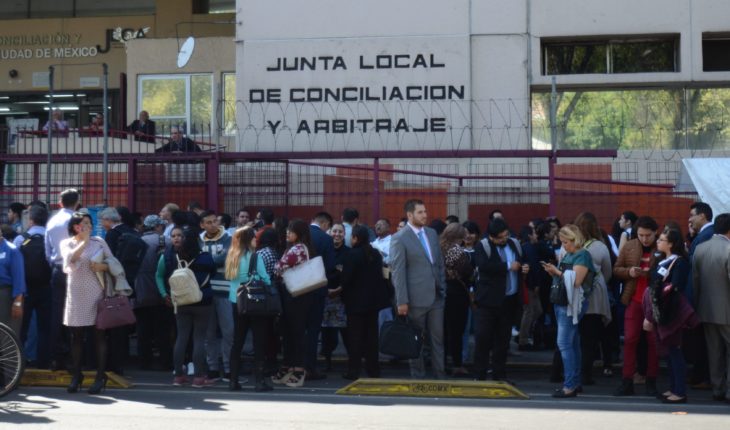The constitutional reform on labour justice that was passed last May seeks to create a new system in which workers and employers resolve their disputes promptly and expeditiously. Its approval is part of Mexico’s negotiations for the signing of the Trade Treaty between Mexico, the United States and Canada (T-MEC), however, to say from specialists, there is no guarantee that the changes could be satisfactorily implemented.
The entry into force of the T-MEC is a fact, as the governments of the United States, Mexico and Canada on Tuesday signed an amending agreement that paves the way for ratification at the congresses of the three countries.
For the first year of implementation, which includes 10 entities of the Republic, the Labor Reform has 1,401 million pesos allocated in the Budget of Egress of the Federation 2020.
And there is already commitment to allocating resources in the following years. Last October 14, in a letter to U.S. Congressman Richard Neal, President Andrés Manuel López Obrador pledged to invest another $829 million: $176.3 mdd by 2021; 324.8 mdd for 2022 and 327.9 mdd for 2023.
The substantial change in the reform is the disappearance of the Conciliation and Arbitration Boards (JCA), since the jurisdiction of labor disputes, until now the responsibility of the Executive Branch, will be reassigned to the Judiciary.
In addition, a federal work-related conciliation and registration center will be created, which, say specialists, was one of the conditions on the part of U.S. congressmen to support TMEC.
This is how we intend to solve a collapsed system where it is almost impossible for there to be real and expeditious justice for the parties. 80,000 new cases are accumulated each year in the system and trials, which would have to be concluded within 105 days, which will last for years.
Read: The slow and tortuous path to resolving a labor dispute in Mexico
Close relationship between T-MEC and Labour Reform
For Joyce Sadka, academic at the Instituto Tecnológico Autónomo de México, the relationship between the t-MEC firm and labor changes in our country is “very close”. Proof of this assured the four years established as the maximum time to implement the reform.
“The four-year thing has been very important for the T-MEC to be signed. Americans were unwilling to be eight years, as was the subject of criminal reform,” Sadka said.
The specialist considered that another requirement of the T-MEC was to ensure that the work conciliation and registration centre, under the Labour Reform, is truly autonomous and provides the assurance that there is a good implementation of the new law.
“Even in past days it was openly mentioned that there were U.S. inspectors to verify labor compliance,” he added
Version referred to by Mexican negotiator and undersecretary of foreign affairs Jesus Seade after the signing of the TMEC amending agreements.
“The most high-key issue” between Mexico and the United States, which stalled the negotiations “for several months,” was the requirement that U.S. labor inspectors verify compliance with labor law in Mexican companies, something that, with the amendments to the T-MEC, was ruled out, since it was seen as an intrusion “that violated Mexico’s national sovereignty.”
Seade explained that the figure of US treaty compliance “inspectors” is not considered, but rather of “panels” that will analyze irregularities.
Each panel will be composed of three specialists in the topic under discussion: a Mexican specialist, who will choose the United States; another American, who will choose Mexico; while the third may be Canadian, or of another nationality.
“These panels will review labor disputes and make a decision on them,” said Seade, who considered this new panel system to be “ground gold for Mexico,” since before, in the old Free Trade Agreement, it did not exist.
Dysfunction of functions generates skepticism
Special Board President No. 1 of the Mexico City Conciliation and Arbitration Board, Lauro Jonathan Sol Orea, said it is necessary to make a profound change in the labor justice system as “no board” in the country is currently “truly autonomous” as they have become “the spoils” of governors and labor secretaries.
However, he believes that sending labor justice to the judiciary is not the solution: “I argued in the pre-reform forums that the solution was to create more together. To give them true autonomy, to turn them into autonomous constitutional bodies and thereby to resolve dependence on the executive branch”.
For the official” “the judiciary is not a guarantee of either honesty or capacity” and far from disappearing the local conciliation and arbitration boards should have been strengthened “and thereby ensure effective and close justice to the people, without the formalities of the judiciary.
Joyce Sadka said: “The law says that cases known to local boards or the federal junta, until the day they close their doors, will have to be managed in those instances, this implies that they will have to have a budget but at the same time the labor courts will work, then there will be a doubling of budgets for several years.”
Roldán Arturo Rocha Hernández, a labor litigator at the firm Marvan and Muñoz abogados agrees with the ITAM specialist: “Where we are a little skeptical is in implementation, the boards will continue to function until the issues they know are concluded, then we will have for some years two different agencies deizing the same kind of controversies”.
At this point Sol Orea agrees with Sadka and Rocha Hernández: “You have to understand that the meetings are going to continue until all the matters you have are finished. If it’s the four years that are said for the courts to start operating, at least here in Mexico City the board will have about 150,000 trials. When are we going to finish resolving those trials? 10 years ago I have very little time. So we’re going to be together and courts simultaneously, and that’s going to multiply the costs. They didn’t see that or they didn’t want to see it.”
Beyond the doubts in implementation, the experts highlighted aspects of labour reform such as strengthening the conciliation stage.
“The other colorful issue is the issue of the mandatory conciliation instance, because today, even if they are called conciliation and arbitation together and the first hearing is called conciliation, it is not mandatory for the parties to sit in a hearing. Now it will be and the presence of the worker at that hearing will have to be necessary and I think that i find that in my studies I find that giving more information to the worker greatly increases the reconciliation rate in and before the trial,” Sadka added.
On strengthening the reconciliation between employers and workers, Sol Orea has a completely different view: “Labor reform is against the social approach of our laws. It was the only matter that still possessed it because the agrarian right is practically on the canvas. Labour was the only subject that has something of the 1917 Constitution and now they go against it because it hinders big capital and foreign investment. Now a lot of strength is going to be given to conciliation and this always implies a renunciation: if you want to reconcile, put it down to what you get by law. Do you hear my three months? I give you a month and a half, what my wages dropped? Well, I’ll give you a month of fallen wages.”
Justified dismissals, one of the omissions of reform
One of the omissions of labor reform, namely Joyce Sadka and Rocha Hernández, is that the lack of employee productivity was not included as justified dismissal.
“The Federal Labour Law, in section 47, which was not amended in this large reform that has just passed, speaks of the justified causes of separating the worker. It has many fractions but among those reasons is not to fire a person for lack of productivity or be conflicted with his peers,” says Joyce Sadka.
The academic explained that for companies it is “very complicated” to verify that termination of the employment relationship was not the employer’s fault: “It may be that the dismissal is justified but the company has no way to prove it. It also happens that there is no redundancy and the worker simply stops filing and demands.
In the same vein, Rocha Hernández said that the legislation is “very rigid” when it comes to the workers’ defence and this is reflected in Article 47 which provides for “very few” grounds for dismissal.
For the litigant there are many justified dismissals, “but as the laws stand,” the employer has to assess whether he will have the elements to defend himself in trials.
What we do in Animal Político requires professional journalists, teamwork, dialogue with readers and something very important: independence. You can help us keep going. Be part of the team.
Subscribe to Animal Politician, receive benefits and support free journalism.#YoSoyAnimal
translated from Spanish: Pending job changes in Mexico for t-MEC
December 11, 2019 |





